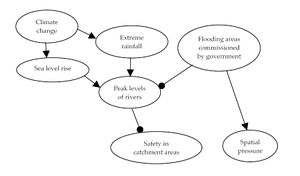Stakeholder analysis
This article looks briefly at the role of stakeholders in the process if coastal zone management. It provides an introduction to a new qualitative approach to developing management strategies through a structural approach to the participatory process. The discussion of the 'practicalities' of adopting such an approach is based on the results of two workshops.
Contents
What do we mean by stakeholder ?
A stakeholder is an individual or an institution who can be positively or negatively impacted by, or cause an impact on the success of a project or a planning process. When an Integrated Coastal Zone Management (ICZM) process is launched, this requires the involvement of any relevant institutions that have stakes regarding the issues underlying the ICZM process. This allows concerted actions and participation for the decision-making process in public policies, allowing that the decisions are shared and taken in an interactive manner enhancing their acceptability in a long-term view.
Stakeholders can be classified into public and private stakeholders. Public stakeholders refer to public representatives at the municipal level (mayor, municipal council, etc.), the regional level (environmental department, etc.), the national level (State, ministry, etc.) and the international level (an international body as the FAO, OECD, UNEP, etc.), whereas private stakeholders refer to the sectoral level (tourism, fisheries, etc.) or the citizen level (a local resident organisation, a leisure / sport society, etc.).
The word Actor can sometimes be used in the same way as Stakeholder.
For other insights in the Coastal Wiki, see also stakeholders.
Tools for stakeholder analysis
Many (computer) tools exist, aimed at involving stakeholders in the decision-making process. A rough distinction can be made between qualitative and quantitative tools. Quantitative tools include Multi-Criteria Analysis (MCA) tools, which allow stakeholders to assign weights to certain variables and indicators. These tools are designed for well-defined, structured problems. However, in practice stakeholder consensus on the problem structure is usually lacking. Then, how to determine an appropriate set of variables and indicators? At this point, qualitative tools can be helpful.
The Quasta tool
Aim of this article is to explore the practical opportunities for the new so-called Quasta approach. The Quasta approach uses a qualitative tool in order to structure complex problems in a group setting. The tool is based on a combination of Cognitive Mapping and Qualitative Probabilistic Networks. For more technical information see the full paper. This paper discusses Quasta as an interactive problem structuring tool, that can be used to involve stakeholders in Integrated Coastal Zone Management (ICZM). The Quasta tool comprehends a new type of computer system which is quite simple and flexible as well. Quasta allows scenario exploration with simple cause-and-effect diagrams.Testing Quasta
The tool is tested in two workshops in which various coastal management issues were discussed. The first workshop took place in September 2006 in Concepción, Chile. The symposium was organised by the CENSOR INCO-project ('Climate variability and El Niño Southern Oscillation: Implications for Natural Coastal Resources and Management') in combination with the Pasarelas project, which is about 'Interface Tools for Multi-stakeholder Knowledge Partnerships for the Sustainable Management of Marine Resources and Coastal Zones'. In the workshop 11 persons participated, from various backgrounds (scientists, executives from governmental departments in Peru and Chile, people from local fishing communities, etc.). The language was Spanish and the topic of discussion was restricted management areas for fisheries. The second workshop was part of the project 'Sustainable living in the Dutch coastal zone', which was an exploratory project about the Dutch coastal zone in 2080. Eight persons participated in this workshop, which was held in October 2006, in Delft, The Netherlands. The group of participants included researchers, consultants and policymakers. The language was Dutch and the topic of discussion was living in the Dutch coastal zone in 2080. This scenario was discussed with respect to the themes 'land use', 'economy', 'safety', 'energy', 'technology & innovation' and 'institutional aspects'.
Conclusions
Evaluations of these workshops show that (1) this system helps stakeholders to make them aware of causal relationships, (2) it is useful for a qualitative exploration of scenarios, (3) it identifies the quantitative knowledge gaps of the problem being discussed and (4) the treshold for non-technicians to use this tool is quite low. As such, these first results seem promising. In order to make Quasta most useful, it is recommended to do further research on the methodology and last but not least to have more practical applications.
See also
- Introduction of public participation
- Problem structuring in decision-making processes
- Decision support tools
Please note that others may also have edited the contents of this article.
|
